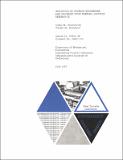| dc.contributor.author | Yovanovich, M. Michael | en_US |
| dc.contributor.author | Rohsenow, Warren M. | en_US |
| dc.contributor.other | Massachusetts Institute of Technology. Dept. of Mechanical Engineering. | en_US |
| dc.contributor.other | Massachusetts Institute of Technology. Heat Transfer Laboratory. | en_US |
| dc.date.accessioned | 2011-03-04T23:35:51Z | |
| dc.date.available | 2011-03-04T23:35:51Z | |
| dc.date.issued | 1967 | en_US |
| dc.identifier | 14135679 | en_US |
| dc.identifier.uri | http://hdl.handle.net/1721.1/61483 | |
| dc.description.abstract | This work deals with the phenomenon of thermal resistance between contacting solids. Attention is directed towards contiguous solids possessing both surface roughness and waviness. When two such surfaces are brought together under load, they actually touch at isolated microcontacts, and the resulting real area is the sum of these microcontacts. Because of the waviness the microcontacts are confined to a region called the contour area which may occupy some fraction of the total available area. The non-uniform pressure distribution over the contour area results in microcontacts which vary in size and density. In the absence of an interstitial fluid and negligible radiation heat transfer, all the heat crossing the interface must flow through the microcontacts. A thermal analysis, based on size and spatial distribution, results in a thermal resistance equation which differs from previously developed theories. The equation is verified by liquid analog tests which show that the size and spatial distribution are very significant. | en_US |
| dc.description.abstract | (cont.) A surface deformation analysis considers the influence of surface roughness upon the elastic deformation of a rough hemisphere. An equation is developed which shows the extent of the contour area as a function of the surface geometry, the material properties, and the applied load. The equation is compared with existing theories and qualitatively checked against experimental results. Experimental heat transfer data were obtained to verify the thermal and deformation theories. The agreement between theory and test is quite good over a large range of surface geometry and applied loads. | en_US |
| dc.description.sponsorship | Sponsored by the National Aeronautics and Space Administration DSR | en_US |
| dc.format.extent | 137 p., [37] p. of plates | en_US |
| dc.publisher | Cambridge, Mass. : M.I.T. Dept. of Mechanical Engineering, [1967] | en_US |
| dc.relation.ispartofseries | Technical report (Massachusetts Institute of Technology, Heat Transfer Laboratory) ; no. 48. | en_US |
| dc.subject | Heat -- Transmission. | en_US |
| dc.subject | Surfaces (Technology) | en_US |
| dc.subject | Thermal analysis. | en_US |
| dc.title | Influence of surface roughness and waviness upon thermal contact resistance | en_US |
| dc.type | Technical Report | en_US |
